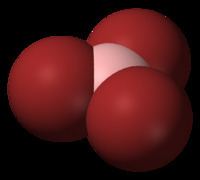Density 2.64 g/cm³ Molar mass 250.52 g/mol | Formula BBr3 Boiling point 91 °C | |
 | ||
Appearance colorless to amber liquid Related compounds | ||
Boron tribromide periodic table of videos
Boron tribromide, BBr3, is a colorless, fuming liquid compound containing boron and bromine. It is decomposed by water and alcohols.
Contents
- Boron tribromide periodic table of videos
- Boron tribromide air exposure
- Chemical properties
- Synthesis
- History
- Applications
- References
Boron tribromide air exposure
Chemical properties
Boron tribromide is commercially available and is a strong Lewis acid.
It is an excellent demethylating or dealkylating agent for the cleavage of ethers, also with subsequent cyclization, often in the production of pharmaceuticals.
The mechanism of dealkylation of tertiary alkyl ethers proceeds via the formation of a complex between the boron center and the ether oxygen followed by the elimination of an alkyl bromide to yield a dibromo(organo)borane.
ROR + BBr3 → RO+(−BBr3)R → ROBBr2 + RBrAryl methyl ethers (as well as activated primary alkyl ethers), on the other hand are dealkylated through a bimolecular mechanism involving two BBr3-ether adducts.
RO+(−BBr3)CH3 + RO+(−BBr3)CH3→ RO(−BBr3) + CH3Br + RO+(BBr2)CH3The dibromo(organo)borane can then undergo hydrolysis to give a hydroxyl group, boric acid, and hydrogen bromide as products.
ROBBr2 + 3H2O → ROH + B(OH)3 + 2HBrIt also finds applications in olefin polymerization and in Friedel-Crafts chemistry as a Lewis acid catalyst.
The electronics industry uses boron tribromide as a boron source in pre-deposition processes for doping in the manufacture of semiconductors. Boron tribromide also mediates the dealkylation of aryl alkyl ethers, for example demethylation of 3,4-dimethoxystyrene into 3,4-dihydroxystyrene.
Synthesis
The reaction of boron carbide with bromine at temperatures above 300 °C leads to the formation of boron tribromide. The product can be purified by vacuum distillation.
History
The first synthesis was done by M. Poggiale in 1846 by reacting boron trioxide with carbon and bromine at high temperatures:
B2O3 + 3 C + 3 Br2 → 2 BBr3 + 3 COAn improvement of this method was developed by F. Wöhler and Deville in 1857. By starting from amorphous boron the reaction temperatures are lower and no carbon monoxide is produced:
2 B + 3 Br2 → 2 BBr3Applications
Pharmaceutical Manufacturing
Image Processing
Semiconductor Doping
Semiconductor Plasma Etching
Photovoltaic Manufacturing
Reagent for Various Chemical Processes
